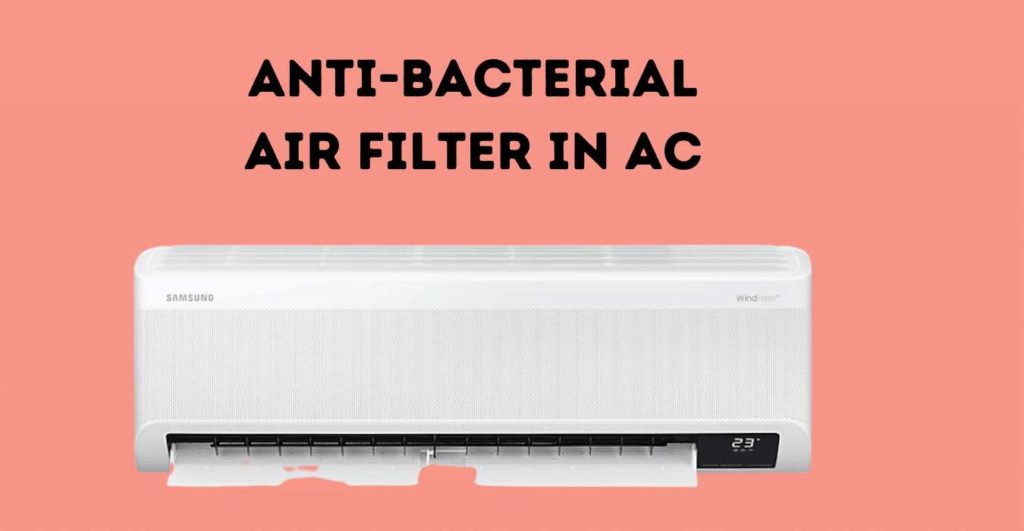Anti-Bacterial Filter in Air conditioners is the latest innovation in purification technology. Not surprisingly, there are times when the air indoors is more polluted than the outdoors. The reasons could be plenty; development of moulds, scaling of paint and subsequent flaking off, indoor smoking, charring and development of grease emerging from cooking, and much more. So, how do you deal with all this? While altering your lifestyle might be an obvious solution, it is not possible for most people. Aspects such as renovation and changing one’s residence might be practical, yet it is not entirely feasible for most people. Therefore, the next best possible solution is to try and enhance indoor air quality. This is where the application and importance of the anti-bacterial filter in AC come into the picture.
Contents
What is Anti- Bacterial Filter in Air Conditioner?


This is one of the most ‘popular’ choices in the indoor filter system. However, the Anti-bacterial filters work in combination with the other filters present in the Air conditioning system. The Anti-Bacterial filter’s main function is to eliminate the harmful irritants circulating in the indoor air and prevent them from re-entering the air circulation system.
This not only improves indoor air quality but also helps Air conditioning to perform well and cool the air more efficiently.
Also Read: Best Air Conditioner(AC) in India
The Working of Anti-Bacterial Filter
The anti-bacterial filter is negatively charged and works by attracting the positively charged elements and other microorganisms circulating in the air. The main aspect of the efficiency of the Anti-bacterial filter is the fact that it blocks the passage of irritants from entering the cooling system and keeps them trapped. Hence the air circulating indoors is cleaner and gets better with time. The filters can work effectively for three months before you might want to replace them. Here are the steps that are involved in the working of the Anti-bacterial filters:
Also Read: Best Pedestal Fan in India
Straining
This involves ‘restricting’ the entry of harmful particles into the cooling system. This step is also known as ‘Trapping,’ as the pollutants are ‘trapped’ in the filters and prevented from recirculating in the indoor air.
Interception
This involves the collision of the larger pollutants and the fibre of the filter during airflow. The efficiency of this step depends upon the closeness of the spaces between the fibres and how well they reinforce if and when the pressure is applied.
Also Read: Best Microwave Oven in India
Diffusion
This step of rather the process represents the random collision of the particles with the fibres. With the further passage of the particles into the fibres, the dust and other elements tend to get stuck onto the concentrated areas of the filter, hence creating a void in the other parts. Thus, the other particles get attracted and hence get trapped as a result.
Inertial Separation
This is where the law of inertia is applied, where the moving objects stay in motion and the ones that remain still if no resistance is applied. This way when the particles can be removed or eliminated as required with the application of Resistance accordingly.
Electrostatic Attraction
The electrostatic principle is all about two charges moved or restricted by influencing their polarities. The main attraction occurs when the opposite charges contact each other within a certain range. Hence, the pollutants are charged with a certain polarity oppositely so that the field of attraction is formed.
The Advantages Of The AC With Anti-Bacteria Filter
Let us take a look at some of the major benefits of the anti-bacterial filters:
- One of the major advantages of the Anti-bacterial air filter is that it can filter out bacteria, viruses, other harmful microbes, spores, and pollen dust.
- It has been reported that Anti-bacterial filters if used regularly, can help enhance indoor air quality with time.
- Not just the air quality, it has been observed that the use of anti-bacterial air filters can also help enhance the cooling system’s performance and keep it working in top condition.
- With the enhanced performance of the Air conditioner, the electric bills are also kept under check, hence helping you save in the long term.
- This filter type is used quite affordable but also easy to install.
- One can also clean and maintain the anti-bacterial filter by themselves.
The Disadvantages Of The Antibacterial Ac Filter
Let us take a look at some of the disadvantages of the Anti-bacterial filters:
- One of the major disadvantages of the Ac Filters is that these have a very small ‘working life span.’ You will have to replace the filter every three months to maintain the indoor air quality and the AC’s efficiency.
How to Make the Right Choice?
It is not simple to just opt for any Anti-bacterial air filter. Here are a few aspects you can consider to make the right choice:
- It is necessary to ensure that the filter size matches your Air conditioning system.
- It is recommended that you must opt for the Anti-bacterial filter that has a compatible pore size and is from a reputed brand.
- Finally, it is also recommended to make sure that the anti-bacterial filter you have chosen is highly efficient and must ‘match’ with the air conditioning system.
Anti-Bacterial Filter in Air Conditioner: The Conclusion
These are a few facts, features, and working of the Anti-bacterial filters. As we are emerging further into urban living, it becomes more vital that we consider the air we breathe in and the general lifestyle we are a part of. While most aspects are not within the individual’s control, certain aspects, like the appliances we use and the features we opt for, need to be taken into account. This goes a long way in helping you make at least your ‘indoor air’ cleaner and better.